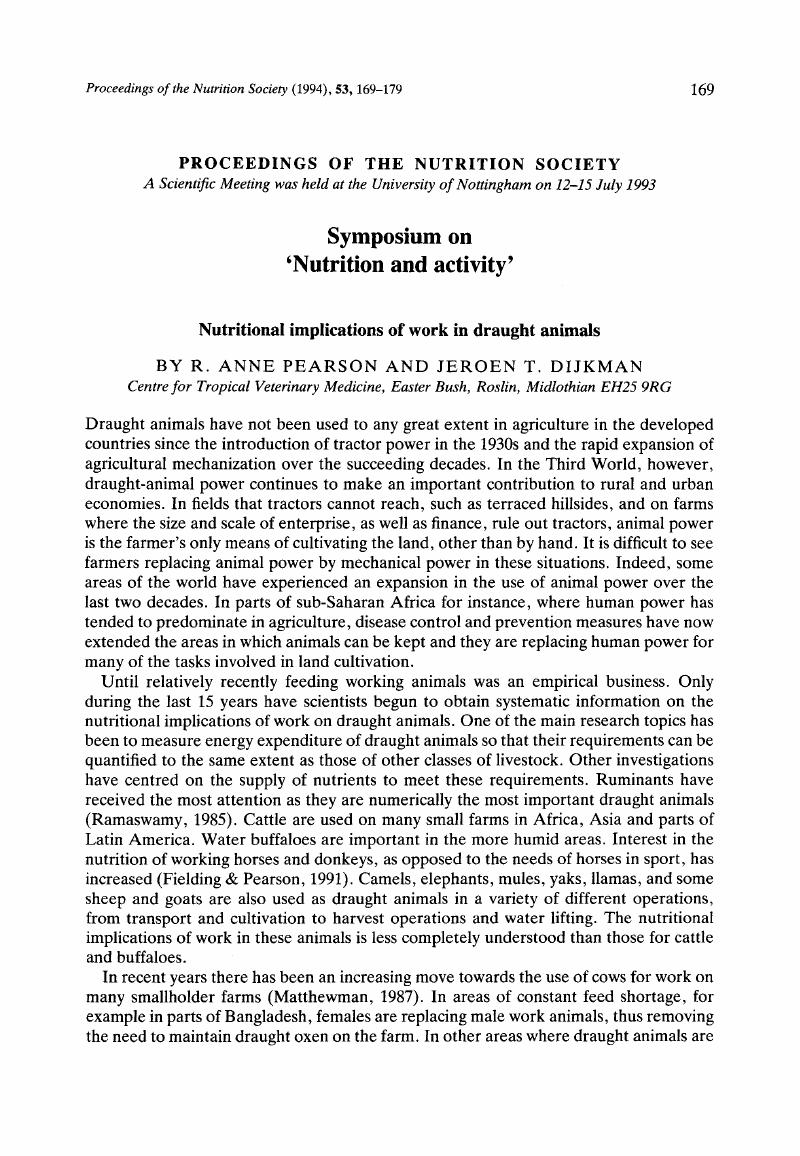Crossref Citations
This article has been cited by the following publications. This list is generated based on data provided by
Crossref.
Pérez, R.
Valenzuela, S.
Merino, V.
Cabezas, I.
García, M.
Bou, R.
and
Ortiz, P.
1996.
Energetic requirements and physiological adaptation of draught horses to ploughing work.
Animal Science,
Vol. 63,
Issue. 2,
p.
343.
Fall, A.
Pearson, R. A.
Lawrence, P. R.
and
Fernández-Rivera, S.
1997.
Nutrition of draught oxen in semi-arid west Africa. 2. Effect of work on intake, apparent digestibility and rate of passage of food through the gastro-intestinal tract in draught oxen given crop residues.
Animal Science,
Vol. 64,
Issue. 2,
p.
217.
Fall, A.
Pearson, R. A.
and
Fernández-Rivera, S.
1997.
Nutrition of draught oxen in semi-arid west Africa 3. Effect of body condition prior to work and weight losses during work on food intake and work output.
Animal Science,
Vol. 64,
Issue. 2,
p.
227.
Kaushik, S.J
1999.
Animals for work, recreation and sports.
Livestock Production Science,
Vol. 59,
Issue. 2-3,
p.
145.
Pearson, R. A.
Zerbini, E.
and
Lawrence, P. R.
1999.
Recent advances in research on draught ruminants.
Animal Science,
Vol. 68,
Issue. 1,
p.
1.
Santos, S.A.
Silva, R.A.M.S.
Azevedo, J.R.M.
Mello, M.A.R
Soares, A.C.
Sibuya, C.Y.
and
Anaruma, C.A.
2001.
Alterações séricas de proteína total e eletrólitos em cavalo Pantaneiro durante exercício de longa distância.
Arquivo Brasileiro de Medicina Veterinária e Zootecnia,
Vol. 53,
Issue. 3,
p.
351.
Jenet, A.
Fernandez-Rivera, S.
Tegegne, A.
Yimegnuhal, A.
Osuji, P.O.
and
Kreuzer, M.
2004.
Growth and feed conversion of Boran (Bos indicus) and Holstein×Boran heifers during three physiological states receiving different levels of a tropical diet.
Livestock Production Science,
Vol. 89,
Issue. 2-3,
p.
159.
Hura, Vladimír
Novotný, Franišek
Boldižár, Martin
Rédl, Martin
Noskovičová, Jana
Horňák, Slavomír
Petrovič, Vladimír
Lazar, Gabriel
and
Kováč, Gabriel
2013.
Biochemical responses to a non-standard exercise in horses trained for jumping.
Acta Veterinaria Brno,
Vol. 82,
Issue. 2,
p.
161.
Sartori, C.
Guzzo, N.
Normando, S.
Bailoni, L.
and
Mantovani, R.
2017.
Evaluation of behaviour in stabled draught horse foals fed diets with two protein levels.
Animal,
Vol. 11,
Issue. 1,
p.
147.
Poškienė, Indrė
Juozaitienė, Vida
Gruodytė, Renata
and
Antanaitis, Ramūnas
2020.
The effect of 60 km endurance exercise on serum electrolytes and acid–base balance in the Žemaitukai horses.
Acta Veterinaria Brno,
Vol. 89,
Issue. 2,
p.
125.
Poškienė, Indrė
Gruodytė, Renata
Autukaitė, Jurgita
Juozaitienė, Vida
and
Antanaitis, Ramūnas
2021.
Speed and Blood Parameters Differ between Arabian and Žemaitukai Horses during Endurance Racing.
Animals,
Vol. 11,
Issue. 4,
p.
995.
Mota-Rojas, Daniel
Braghieri, Ada
Álvarez-Macías, Adolfo
Serrapica, Francesco
Ramírez-Bribiesca, Efrén
Cruz-Monterrosa, Rosy
Masucci, Felicia
Mora-Medina, Patricia
and
Napolitano, Fabio
2021.
The Use of Draught Animals in Rural Labour.
Animals,
Vol. 11,
Issue. 9,
p.
2683.
2022.
Ye’i, Yohannes Urgesa
Mummed, Yesihak Yusuf
Kurtu, Mohammed Yusuf
Leta, Mengistu Urge
O’Quinn, Travis Gene
and
Kebede Kefenie, Kefelegn
2024.
Beef quality of Hararghe highland bull following different hours of draught service.
Acta Agriculturae Scandinavica, Section A — Animal Science,
p.
1.





